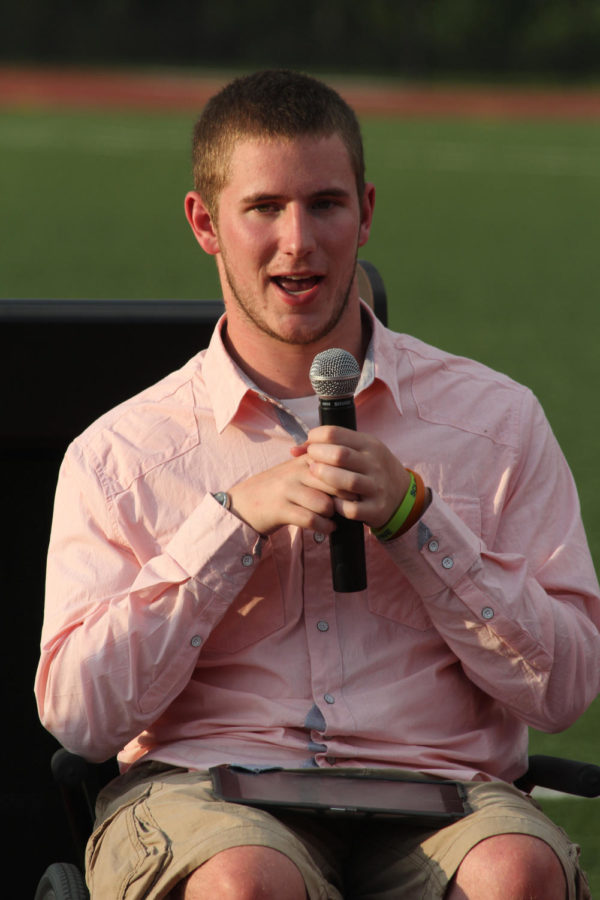Inspiring disabled athletes: Chris Norton shares story at disability championships opening ceremonies
Iowa State is hosting National Junior Disability Championships from July 5 to 12. Chris Norton, 22, a Luther College student who broke his neck in a college football game, shared his story and feelings in front of an audience of hundreds of people during the the opening ceremony.
July 8, 2014
This week, Ames and Iowa State will host to the National Junior Disability Championships. As of late, the city and university have had a knack of providing facilities for these types of events.
In late May, Iowa State hosted Iowa’s 30th annual Special Olympics Summer Games.
From June 19 to 21, Ames Middle School hosted the goalball nationals, a sport for the visually impaired. Both events were sponsored by Adaptive Sports Iowa, which was founded in by Mike and Joni Boone.
“We want to bring events like this to Iowa to engage new potential athletes, but we also like to expand what the public definition of what disability is,” Mike said.
The National Junior Disability Championships consist of more than 200 athletes between the ages of 7 and 21 who have met the appropriate requirements with the Disabled Sports Organizations by qualifying at a regional meet or approved tournament.
The five events at the championship tournament are archery, track and field, swimming, table tennis and power lifting.
The National Junior Disability Championships began in July 1984 and consisted of only wheelchair events for wheelchair athletes ages seven to 19.
Over the years, the National Junior Disability Championships includes athletes with spinal injuries, cerebral palsy, visual impairments, amputations, limb deficiencies and other congenital anomalies, according to the National Junior Disability Championship’s website.
This will be the first time that the event is hosted in Ames.
“When you have access to facilities like these, it’s very easy to convince people to come in,” Mike said, in reference to the newly built Cyclone Sports Complex, completed in 2012.
At the opening ceremony July 6, the keynote speaker was a hometown Iowa boy named Chris Norton. Norton attended high school at Bondurant-Farrar and was a football player at Luther College in Decorah, Iowa.
On Oct. 16, 2010, Norton broke his neck and fractured his C3 and C4 vertebrae in a collision during a kickoff when he tried to tackle the ball carrier. The doctors told Norton that he had a 3 percent chance of ever walking again.
Norton never cared much for statistics and took it upon himself to beat those odds.
The normal amount of therapy for people recovering from these types of injuries is about an hour a day with tasks such as moving the head up and down, Norton said.
When it came to recovering from his injury, Norton recalls how the nurses and doctors wanted him to acclimate himself to his new lifestyle. Norton would have nothing to do with this, asking for and receiving up to three hours of therapy a day, which is more than anyone has ever seen at the Mayo Clinic in Rochester, Minn., Norton said.
Norton said that not everyone with the same story as him gets the treatment he has received.
“I learned that the opportunities I’ve had [are] because of the NCAA insurance, my own personal insurance and my family and friends,” Norton said. “[But] there are a lot of people out there with similar stories as me, but they get cut off of their therapy three months in.”
Norton learned of those types of cases and started the SCI CAN Foundation, raising money and awareness for those in need of therapy.
“We are seeking to improve the quality of therapy for individuals with spinal cord injuries [SCI] and other neuromuscular deficiencies,” according to the SCI CAN Foundation’s website. “We want to raise money to buy equipment that most local facilities cannot afford.”
The foundation and Norton are examples of how dedication and hard work can pay off for anyone with a physical or mental disability. Norton can now stand on his own for 10 minutes without assistance.
Whether it is bench pressing 350 pounds or winning races on the track, the athletes at the National Junior Disability Championships compete physically and mentally at the highest possible level.
More information on Norton’s SCI CAN Foundation can be found at scicanfoundation.com







